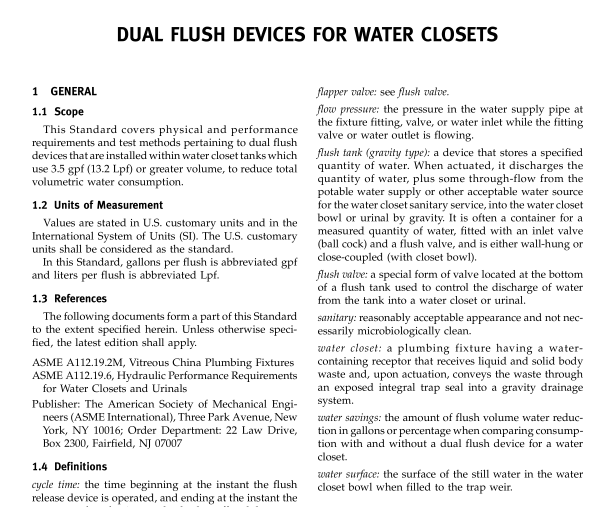ASME A112-19-10 pdf download

ASME A112-19-10 pdf download DUAL FLUSH DEVICES FOR WATER CLOSETS
2.2 Durability The product shall meet the performance requirements of the cycle test in para. 3.2. Materials that are immersed in or exposed to water in the tank shall conform to requirements for longevity and resistance to corrosion, adsorption, and dimensional stability.
2.3 Hydraulic Performance Separate dual flush devices installed in water closet tanks shall meet the hydraulic performance tests in para.
3.3 when tested on two ofthree differentselected sample product water closets submitted for tests or provided by the testing laboratory. If failure of any of the tests occurs, the third water closet and a new dual flush assembly shall be tested. Any added failures of either assembly and/or performance failure ofthe water closet shall be cause for rejection of the device. Label restric- tions on the installation of the device(s) to any single or group of manufacturers’ water closets shall be speci- fied on a distinctive color caution label on the package or instructions by the manufacturer, producer, or provider of the device(s) in the event of demonstrated fail- ures for those models.
3 TESTING
3.1 Functional Operation Test
3.1.1 Dual Flush Device Test Method. The dual flush device shall be installed and adjusted in accordance with the manufacturer’s installation instructions in the water closet tank(s) with volume of3.5 gpf(13.2 Lpf) or greater selected for test (of the three water closet product sam- ples provided). The dual flush handle or other actuation selector shall be independently operated to evaluate freedom of parts to move when the fixture is empty and normally filled, unless intrinsic design of the device requires constraints related to its functional per- formance. 3.1.2 Performance Requirement. Parts shall not bind or seize when operated. Settings according to the manu- facturer’s instructions should not cause leakage.
3.2 Cycle Testing
3.2.1 Cycle Testing of the Flush Valve Assembly
3.2.1.1 Test Method. Install the flush valve in a tank that contains a steady water supply and controls the water level to a maximum height of 7 ± 1 ⁄ 4 in. (178 ± 6 mm), or as marked on the fixture tank if less, above the flush valve seat. Place a volume of water in the tank to the same water level height above the flush valve seat. Allow to stand for 60 ± 3 min and observe any leakage of water from the flush valve outlet. No leakage shall be observed. Conduct cycle testing by opening and closing the flush valve assembly for 75,000 continuous cycles. Tank walls may be dammed for accelerated tests if the device and all associated hardware are immersed to represent actual installation conditions with the hydraulic head maintained. The full displacement of operating requirements for each mode of the open–close test cycles shall be to com- plete the full extentofthe motion ofparts to their normal functional stop locations. The entire drain and refill modes need not be completed if the full displacement of the operating parts is achieved. The control mechanism shall be cycled in both modes of operation for the normal-flush and reduced-flush volume discharges with 5:1 actuations as the ratio for the lower to larger flush discharge; i.e., five consecutive reduced flushes and one normal flush. Upon completion of the cycling period, remove any dams and water from the tank. Place a volume of water in the tank to the previous water level height above the flush valve seat. Allow to stand for 60 ± 3 min and observe any leakage ofwater from the flush valve outlet.
3.2.1.2 Performance Requirement. Not more than 2% of the total measured volume of water in the tank shall leak from the flush valve outlet after the cycling is completed and the unit is allowed to stand for 60 ± 3 min.
3.2.1.3 Cycle Testing of the Flapper Valve. The test method and performance requirement of the flush valve assembly shall be conducted for devices that include a flapper valve as part of dual flush system equipment and assembly for installations (see paras. 3.2.1.1 and 3.2.1.2).









